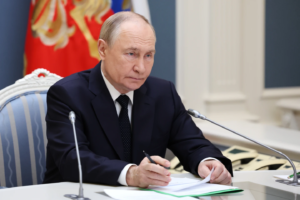Former President Donald Trump posted on social media Thursday he will have another high-profile meeting with Russian President Vladimir Putin in a bid to bring peace to Ukraine — a war now in its fourth year. Trump said the meeting would take place in Budapest, Hungary, but an official date was not announced.
I believe fantastic strides were taken on today’s phone call,” Trump said in a post-call statement following a conversation with Putin earlier this day. The two leaders met together last in Alaska in August, a meeting that failed to yield a diplomatic fruit but laid the groundwork for future talks.

Before the Trump-Putin summit, U.S. Secretary of State Marco Rubio will head a delegation to meet Russian officials next week. The location of those talks is not revealed, a sign of ongoing backchannel diplomacy between Washington and Moscow.
Zelenskyy Demands U.S. Missiles as Trump Seeks to Expand Leverage over Moscow
The latest overture to Moscow comes after Ukrainian President Volodymyr Zelenskyy’s scheduled visit to the White House on Friday, his fourth in-person meeting with Trump this year. Kyiv is calling for Washington to sell it Tomahawk cruise missiles, which would enable Ukraine to reach deeper into Russian-held territory.
Zelenskyy has insisted that such long-range capabilities would strengthen Ukraine’s negotiating position and force the Kremlin to accept more seriously U.S.-backed peace initiatives.
Trump hinted earlier this week that he might use the potential sale of Tomahawks as a bargaining chip against Putin. In remarks to reporters on Sunday’s visit to Israel, Trump said, “Do they want Tomahawks going that way? I don’t think so. I think I may discuss that with Russia.”
The remarks refer to Trump’s strategy of blending economic and military pressure with diplomacy — a shift from President Joe Biden’s, which was considerably sanctions- and global coalition-dependent.
Trump’s Resurgent Commitment to Ending World Conflicts

Ending the wars in Gaza and Ukraine has been Trump’s focus of 2024, wherein he has repeatedly attacked President Biden over managing the two conflicts. With a Gaza ceasefire now holding for the first time in months, however, Trump appears set to ride that tide and urge peace in Eastern Europe.
“Interestingly, we had a good day today because of what has occurred in the Middle East,” Trump told a group of supporters at dinner Wednesday night at his White House ballroom development. He claimed that lessons from the Gaza ceasefire could apply to talks with Moscow and Kyiv.
In a speech at the Israeli Knesset in Jerusalem earlier this week, Trump declared that Gaza ceasefire might contribute to broader normalization between Israel and several Arab states. Trump reiterated, however, that his top foreign policy priority remains ending Europe’s largest war since World War II.
“First we’ve got to get Russia done,” Trump directed his special envoy Steve Witkoff, who has been his go-to man with the Kremlin. “If you don’t mind, Steve, let’s get Russia first. Okay?”
Tomahawks or Tactical Missiles? Analysts Weigh the Options
The sale of Tomahawk cruise missiles, with a range of 1,600 kilometers (995 miles), would mark a huge escalation of U.S. aid to Ukraine. Russian officials have warned that it would be a “red line” and would jeopardize any possibility of future talks.
Aside from the risks, Trump has been hardly discouraged. “He’d like to have Tomahawks,” Trump said Tuesday, speaking to Zelenskyy. “We have a lot of Tomahawks.”
Defense experts note that Ukraine might gain more immediate advantage from shorter-range systems such as Extended Range Attack Munition (ERAM) and Army Tactical Missile Systems (ATACMS).
As the Foundation for Defense of Democracies’ Mark Montgomery pointed out, “The Tomahawk decision is as political as it is military. ERAM and ATACMS could pressure Russian troops at the front lines sooner.”
In early this year, the United States greenlit the sale of up to 3,350 ERAMs to Ukraine, which may strike Russian logistics and command centers within a few hundred kilometers of combat areas.
White House Ponders Fresh Russia Sanctions amid Growing Pressure
Zelenskyy will also likely echo his call for more robust economic sanctions against Moscow in Friday’s session. Trump has thus far been reluctant to impose sweeping sanctions, instead applying pressure to NATO partners and Russia’s biggest buyers of oil to cut back on imports — the monetary gasoline tank of the Kremlin’s war machine.
Trump revealed on Wednesday that India, one of Russia’s largest buyers of crude oil following the invasion, had pledged to begin cutting its purchases — something that could damage Moscow’s revenue stream.
Meanwhile, Congress is also considering bipartisan legislation to impose huge tariffs on nations that continue to trade Russian oil, gas, and uranium. The bill, introduced by Sen. Lindsey Graham (R-S.C.) and Sen. Richard Blumenthal (D-Conn.), has been met with cautious interest from the White House.
Officials briefed on internal deliberations include the following: Trump officials have begun to scrutinize thoroughly the bill, signaling the president soon to back it as part of a strategy of strengthening diplomatic relations in tandem with economic squeezing of Putin.
A White House aide, speaking on condition of anonymity, suggested that the administration wants to ensure that any sanctions “support the president’s foreign policy objectives while providing flexibility.”.
Treasury Secretary Scott Bessent repeated those words Wednesday, emphasizing Washington is seeking “greater buy-in from Europe,” which is under the most direct threat of Russian aggression.
A Delicate Diplomatic Balancing Act
Trump’s renewed engagement with both Putin and Zelenskyy are a testament to his attempt to toe the line between diplomacy and deterrence — a hallmark of his foreign policy strategy. As the world waits for his next face-to-face with Putin to take place in Budapest, there are questions regarding whether Trump’s unconventional style can achieve what eluded past administrations: a lasting peace in Ukraine.




